The Sperm Whale and the Orca are both iconic figures of the ocean, yet they exhibit strikingly different characteristics.
Sperm whales, with their massive blocky heads, can grow up to 60 feet long and mainly feed on squid. They prefer deeper oceanic waters and live in structured social groups. Orcas have a distinct black-and-white coloration, measure up to 32 feet, and have a varied diet that includes fish, seals, and other marine animals. They live in diverse habitats, from coastal waters to open seas, and are known for their intricate pod structures.
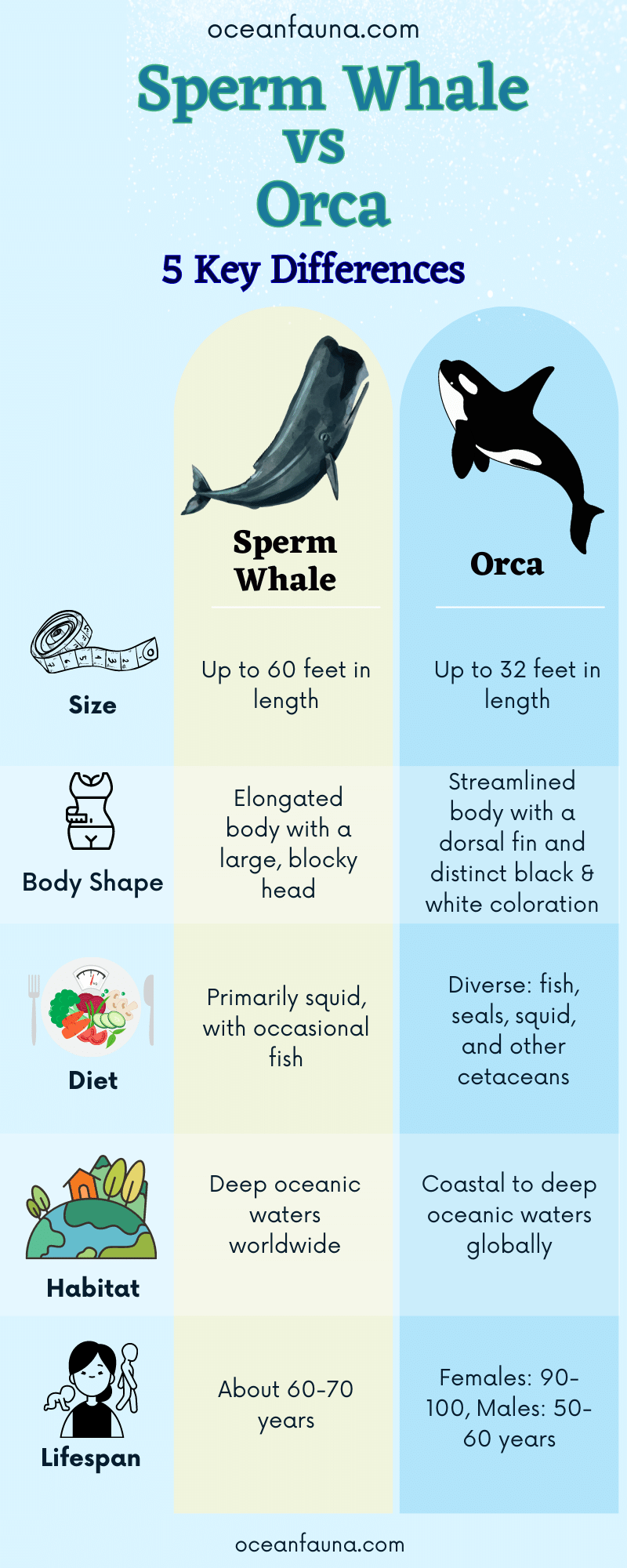
While both these whales are symbols of the vastness and mystery of our oceans, each tells a different tale of life beneath the waves. Dive in as we journey through the captivating contrasts between the Sperm Whale and Orca.
Sperm Whale vs Orca – A Quick Comparison
| Feature | Sperm Whale | Orca |
| Scientific Name | Physeter macrocephalus | Orcinus orca |
| Family | Physeteridae | Delphinidae |
| Body Shape | Elongated body with a large, blocky head | Streamlined body with a dorsal fin and distinct black & white coloration |
| Size | Up to 60 feet in length | Up to 32 feet in length |
| Diet | Primarily squid, with occasional fish | Diverse: fish, seals, squid, and other cetaceans |
| Habitat | Deep oceanic waters worldwide | Coastal to deep oceanic waters globally |
| Social Behavior | Live in structured social groups | Complex pod structures with matriarchal hierarchies |
| Lifespan | About 60-70 years | Females: 90-100, Males: 50-60 years |
| Gestation Period | About 14-16 months | About 17 months |
| IUCN Status | Listed as Vulnerable | Listed as Data Deficient, but some populations are critically endangered |
Sperm Whale vs Orca – What Are the Key Differences?
Sperm Whales and Orcas share the vast, mysterious expanse of our world’s oceans as their playground. Both these cetaceans are apex predators, relying on intricate communication systems and sharp intellect to navigate, socialize, and hunt.
Yet, beneath these shared characteristics, Sperm Whales and Orcas have evolved unique adaptations, behaviors, and lifestyles that set them apart. So, let’s dive deep into these differences.
1. Taxonomy and Scientific Classification
Though both the sperm whale and the orca are toothed whales, they come from different branches of the cetacean family tree.
Sperm Whale
The sperm whale is the largest of the toothed whales and holds the record for having the biggest brain of any creature known to exist.
Scientifically known as Physeter macrocephalus, it belongs to the family Physeteridae. It consists of three species: the sperm whale itself, the dwarf sperm whale, and the pygmy sperm whale. ~Source
Orca
Despite its name, the orca or killer whale isn’t a whale in the traditional sense. It’s basically the largest member of the dolphin family! Scientifically known as Orcinus orca, itbelongs to the family Delphinidae. ~Source
| Taxonomic Rank | Sperm Whale | Orca |
| Kingdom | Animalia | Animalia |
| Phylum | Chordata | Chordata |
| Class | Mammalia | Mammalia |
| Order | Artiodactyla | Artiodactyla |
| Infraorder | Cetacea | Cetacea |
| Family | Physeteridae | Delphinidae |
| Genus | Physeter | Orcinus |
| Species | Physeter macrocephalus | Orcinus orca |
2. Habitat and Distribution
Both species traverse the great waters of the world. Still, there are distinct differences in their preferred habitats and distribution patterns.
Sperm Whale
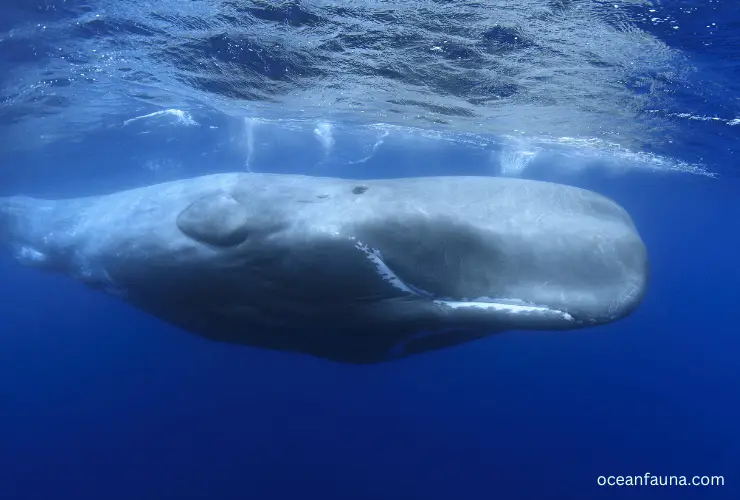
Sperm whales are deep ocean lovers. They prefer areas with deep underwater canyons and trenches. You’ll most likely spot them in depths over 2,000 feet.
They are cosmopolitan and can be found from the polar ice caps to the equator. However, they prefer temperate and tropical waters. Adult males sometimes venture into colder waters, while females and young whales are typically found in warmer areas, as discussed in an article published in the Encyclopedia of Marine Mammals.
Orca
Orcas are more versatile in terms of habitat. While they can also dive deep, they’re equally comfortable in shallower waters, including coastal areas.
Like sperm whales, they are found in oceans worldwide, from the freezing Arctic and Antarctic regions to tropical seas.
However, their distribution is more patchy, with populations often concentrating around cooler, coastal waters rich in food resources. They are more plentiful in cold oceans like Antarctica, Norway, and Alaska, as documented by National Oceanic and Atmospheric Administration.
| Aspect | Sperm Whale | Orca |
| Habitat | Deep oceanic waters with underwater canyons and trenches. | Varied; deep oceanic waters to coastal areas. |
| Distribution | Global, prefers temperate and tropical waters. | Global, prefers cooler, coastal waters with rich food resources. |
3. Physical Appearance
Both the sperm whale and the orca have their own set of physical characteristics that distinguish them from one another.
Sperm Whale
- Size: Adult Sperm whales can reach up to 60 feet in length for males, while females are smaller, averaging around 40 feet.
- Color: Typically dark grey, though some can be a lighter grey. They may have white patches, especially on the belly.
- Head: The head is massive, making up about one-third of its total body length. This houses the spermaceti organ, from which the whale gets its name.
- Teeth: The lower jaw has large conical teeth that fit into sockets in the upper jaw.
- Blowhole: Positioned on the left side of the head’s front, making their blow or spout bent forward and to the left. ~The Marine Mammal Centre
Orca
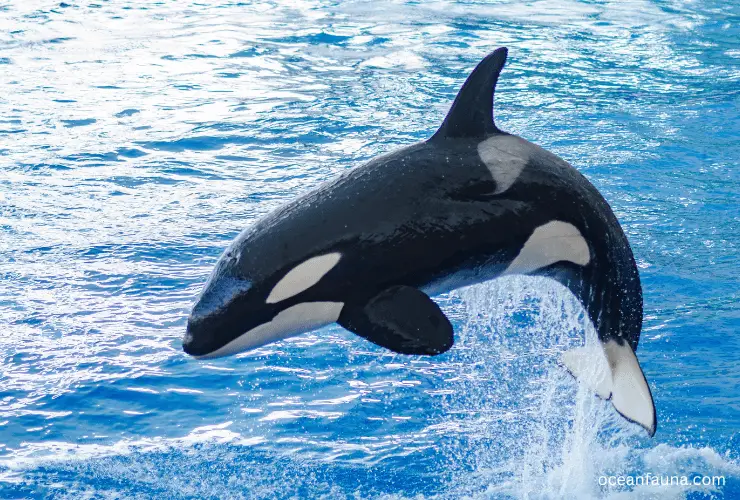
- Size: Adult orcas can reach up to 32 feet for males and up to 23 feet for females.
- Color: Iconic black-and-white pattern. The upper part (dorsal) is mostly black, with a white patch behind each eye and a grayish “saddle patch” behind the dorsal fin. The underside (ventral) is white.
- Head: They have a rounded head with a blunt snout.
- Teeth: Both the upper and lower jaws have strong, interlocking teeth.
- Dorsal Fin: Males have a tall, triangular dorsal fin that can be up to 6 feet tall. Females have a smaller, curved dorsal fin. ~National Geographic
| Feature | Sperm Whale | Orca |
| Size | Males ~60 ft, Females ~40 ft. | Males ~32 ft, Females ~23 ft. |
| Color | Dark grey, with lighter grey or white patches. | Black and white patterned. |
| Head | Massive head, about one-third of total length. | Rounded with a blunt snout. |
| Teeth | Large conical teeth in the lower jaw only. | Strong, interlocking teeth in both upper and lower jaws. |
| Blowhole/ Dorsal Fin | Blowhole angled forward and to the left. | Tall dorsal fin in males (up to 6 ft); Smaller, curved fin in females. |
4. Diet and Feeding Habits
Their feeding habits and diets also show marked differences.
Sperm Whale
- Diet: The sperm whale’s primary diet consists of squid, including the colossal squid and giant squid. They also occasionally eat sharks, skates, and various fish.
- Hunting: Sperm whales are deep-diving hunters. Using their sophisticated echolocation system, they track and capture their prey in the pitch-black environment of the deep sea.
- Teeth: Interestingly, only the teeth in their lower jaw are functional. They use these large conical teeth to grab and hold onto their slippery prey. ~National Oceanic and Atmospheric Administration
Orca
- Diet: Orcas have a varied diet that includes fish (like salmon), birds, seals, sea lions, whales, sharks, and even other dolphins. Different orca pods can specialize in certain prey.
- Hunting: They are strategic hunters, often working in pods to corral and capture prey. For example, they work together to tip ice floes to catch seals.
- Teeth: Orcas have strong, interlocking teeth that can crush bone and tear flesh, allowing them to tackle a wide variety of prey, as detailed in the book Ethology and Behavioral Ecology of Odontocetes.
| Aspect | Sperm Whale | Orca |
| Diet | Primarily squid (including colossal and giant squid). | Varied – fish, seals, sea lions, whales, and sharks. |
| Hunting | Deep dives using echolocation. | Strategic surface and mid-water hunting in pods. |
| Teeth | Large conical teeth on the lower jaw only. | Strong, interlocking teeth on both upper and lower jaws. |
| Group Behavior | Usually solitary or in small groups during hunts. | Often hunt in coordinated pods, displaying complex strategies. |
5. Social Behavior
Both these marine giants exhibit fascinating social behaviors, though in different ways.
Sperm Whale
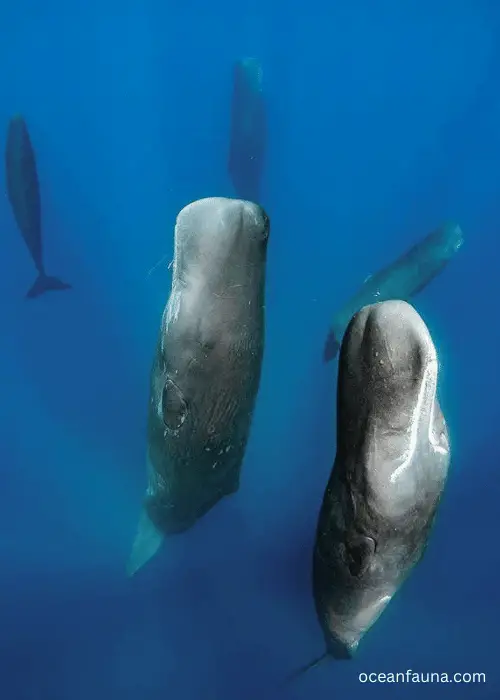
These toothed whales are quite friendly, especially among females and their young.
- Pod Structure: Sperm whale societies are matriarchal. Adult females, calves, and juveniles often form close-knit groups called pods of up to 20 members. In contrast, mature males tend to be more solitary, occasionally joining these pods.
- Communication: They use a complex system of clicks, known as codas, for communication. Different groups might even have distinct “dialects.”
- Nursing and Babysitting: In these female-led pods, females will sometimes assist in caring for and nursing each other’s young—a behavior known as alloparenting.
- Migration: Mature males often migrate long-distance between cold feeding grounds and warmer breeding areas. ~Oregon State University.
Orca
Orcas are known for their intricate social structures. They are one of the few animals that exhibit cultural differences between groups.
- Pod Structure: Orcas live in family groups called pods. These pods are matrilineal, meaning they’re centered around a lineage of related females.
- Communication: They communicate using a variety of clicks, whistles, and pulsed calls. Different pods have their own unique calls or dialects, leading to the idea of orca “cultures.”
- Life-long Bonds: Both male and female offspring often stay with their mothers for their entire lives, leading to tight-knit family units.
- Hunting Strategies: Orcas often hunt cooperatively in their pods, using complex strategies that are passed down through generations. ~Canadian Journal of Zoology
| Aspect | Sperm Whale | Orca |
| Pod Structure | Matriarchal groups of females, calves, and juveniles; males are more solitary. | Matrilineal pods; offspring usually stay with their mothers for life. |
| Communication | Use codas (complex clicks) with distinct “dialects.” | Use clicks, whistles, and pulsed calls; different pods have unique dialects. |
| Group Behaviors | Alloparenting: females may care for and nurse others’ young. | Cooperative hunting strategies that are culturally and generationally passed down. |
6. Reproduction and Lifecycle
Both the sperm whale and the orca have rich reproductive and life journeys that are different in many aspects.
Sperm Whale
- Mating: Sperm whales mate at any time of the year, but most births occur in the spring. Males reach sexual maturity between 18 and 25 years, while females mature earlier, between 7 and 13 years. Males will compete for females, and often the largest and most dominant males mate.
- Gestation: Once pregnant, females carry their young for about 14 to 16 months before giving birth.
- Calves: A newborn calf is about 13 feet long and is nursed for several years.
- Lifespan: Sperm whales can live for over 70 years, with females often outliving males. ~Source
Orca
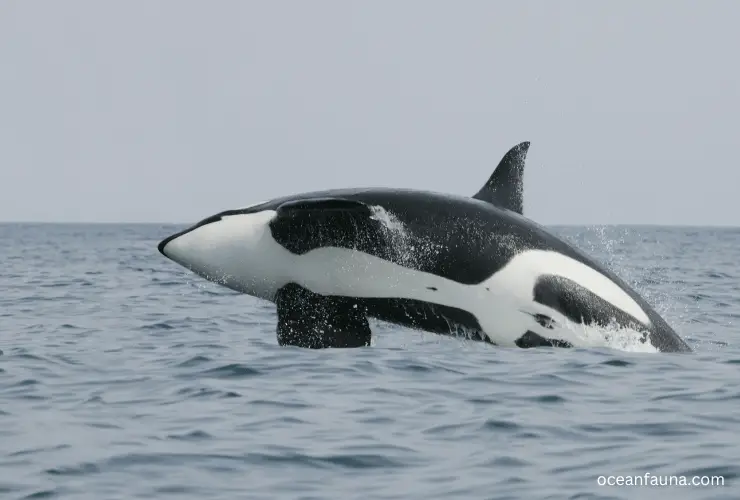
- Mating: Orcas mature sexually between 10 to 18 years, with variations between males and females. Mating doesn’t typically happen within the same pod to avoid inbreeding.
- Gestation: After mating, the female carries her baby for 15 to 18 months.
- Calves: Once born, the calf is about 8.5 feet long. Like sperm whales, orca calves rely on their mother’s milk for the first couple of years and are taught vital life lessons within the safety of the pod.
- Lifespan: Male orcas can live for 50 to 60 years. Females often live longer than males, sometimes even reaching the 100-year mark in some documented cases. ~American Cetacean Society
| Aspect | Sperm Whale | Orca |
| Sexual Maturity | Males: 18-25 years, Females: 7-13 years. | Between 10 to 18 years. |
| Gestation Period | About 14 to 16 months. | Between 15 to 18 months. |
| Calf Size at Birth | Approx. 13 feet (4m). | Approx. 8.5 feet (2.6m). |
| Nursing Duration | Several years. | Initial couple of years. |
| Lifespan | More than 70 years (females often outlive males). | 50 to 90 years (females often live longer, some even up to 100 years). |
7. Natural Predators
While both sperm whales and orcas sit atop the marine food chain, they still have encounters with potential threats.
Sperm Whale
The colossal size and formidable presence of sperm whales make them tough contenders in the deep blue. However, even they aren’t completely free from threats.
Ironically, orcas are known to attack sperm whale calves. These encounters often involve a pod of orcas targeting a calf, even if it’s amidst a group of adult sperm whales. ~Alaska Department of Fish and Game
Orca
Often termed the “wolves of the sea,” orcas are apex predators (at the top of the food chain). Still, they aren’t entirely devoid of concerns.
In some rare instances, orcas have been observed attacking and even consuming members of different orca pods. This behavior, while not entirely understood, might be territorial or competition-driven.
| Species | Marine Predators |
| Sperm Whale | Orcas (especially targeting calves). |
| Orca | Some orca-on-orca aggression (usually between different pods). |
8. Defense Mechanism
Sperm whales and orcas have distinct defense mechanisms that help them survive in their habitats.
Sperm Whale
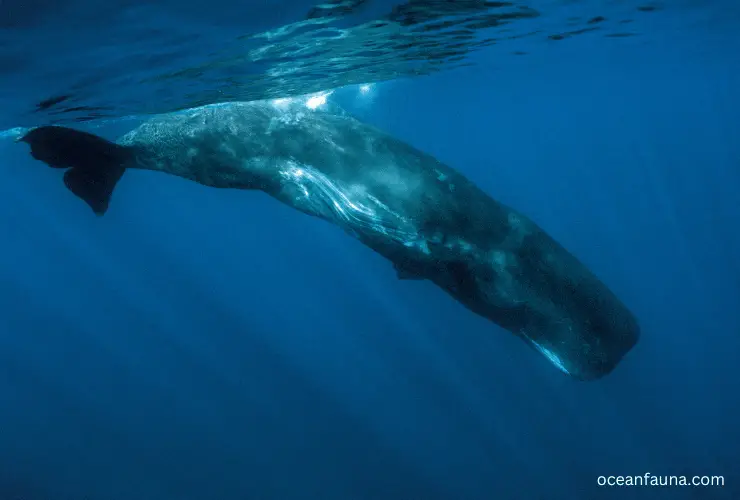
Though they may seem gentle and slow, sperm whales have their own ways of warding off threats.
- Tail Slap: One of the sperm whale’s most powerful defensive moves is a massive slap of its tail on the water’s surface. This can be lethal for any predator or, at the very least, a strong deterrent.
- Echolocation: Using echolocation, sperm whales can detect potential threats from a distance, giving them ample time to either avoid or prepare for an encounter.
- Protective Formation: When threatened by predators, like a group of orcas, sperm whales form a defensive circle with their heads facing out and tails inward. This protects the most vulnerable members, like calves, in the center. ~Source
Orca
The killer whale doesn’t earn its name without reason. They’re skilled and strategic, both in offense and defense.
- Speed and Agility: Orcas are incredibly agile and can reach high speeds (56 km/h), which helps them escape potential threats.
- Teamwork: Operating in pods, they use coordinated strategies to fend off threats or other competing orcas.
- Intimidation: Using their sheer size, unique appearance, and synchronized movements, orcas can intimidate potential threats.
- Tail Slap: Just like sperm whales, orcas too can use their powerful tails to slap and deter potential aggressors, as documented in the International Journal of Avian & Wildlife Biology.
| Aspect | Sperm Whale | Orca |
| Tail Use | Tail slap to deter predators. | Tail slap for both hunting and defense. |
| Group Strategy | Forms a defensive “marguerite” formation to protect vulnerable members. | Uses coordinated pod strategies for both offense and defense. |
| Detection | Echolocation to detect threats from afar. | Uses echolocation but relies more on speed and agility. |
| Intimidation | Relies more on group formations for defense. | Uses size, appearance, and synchronized movements for intimidation. |
9. Interaction With Humans
Both the sperm whale and orca face unique challenges due to human interactions.
Sperm Whale
- Whaling: Unfortunately, the most significant interaction between sperm whales and humans was during the height of the whaling industry. These whales were heavily hunted for their oil, which was a valuable commodity.
- Curiosity: Sperm whales, while generally wary, have occasionally shown curiosity towards human divers, approaching and inspecting them without aggression.
- Collisions: They are at risk from ship strikes due to their presence near the surface on some shipping routes.
Orca

- Capture and Entertainment: For decades, orcas were captured and kept in marine parks, where they performed for audiences.
- Cultural Significance: Indigenous communities, especially Pacific Northwest ones, revere the orca. Orcas feature prominently in their stories, art, and spirituality.
- Research and Observation: Given their intelligence and complex social structures, orcas have been the subject of extensive scientific research. Many regions also promote orca-watching tours as a form of ecotourism.
- Incidental Encounters: Though orcas are apex predators, aggressive encounters with humans in the wild are particularly rare. Most incidents involving orcas and humans have occurred in captivity.
| Aspect | Sperm Whale | Orca |
| Historic Exploitation | Whaled extensively for oil. | Captured for entertainment in marine parks. |
| Modern Encounters. | Occasional curiosity-driven approaches to vessels or divers. | Research, orca-watching tours, and rare wild encounters. |
10. Threats and Conservation Status
Like many creatures, both sperm whales and orca face threats, often from us humans.
Sperm Whale
- Historic Whaling
- Ship Strikes
- Entanglement in fishing nets
- Noise pollution
- Chemical pollution, like heavy metals and plastics
Status: Listed as Vulnerable by the IUCN Red List.
Orca
Orcas are formidable, but they, too, face challenges in today’s changing oceans. These include
- Pollution from chemical contaminants, like PCBs
- Overfishing of some of their primary prey
- Noise Pollution
- Captivity
Status: The IUCN lists orcas as Data Deficient, meaning there’s insufficient information for a comprehensive assessment. However, some specific populations are critically endangered.
| Aspect | Sperm Whale | Orca |
| Main Threats | Whaling legacy, ship strikes, entanglement, pollution. | Pollution, prey depletion, noise pollution, captivity. |
| Conservation Status | Vulnerable | Data Deficient (some populations critically endangered). |
Sperm Whale vs Orca: Who Would Win the Battle?
While the sperm whale is significantly larger and heavier than the orca, size alone doesn’t determine the outcome. The sperm whale’s massive jaw and teeth are formidable weapons. Still, they are primarily adapted for catching squid rather than fighting other large marine mammals.
On the other hand, Orcas are incredibly intelligent and known for their coordinated hunting techniques. In groups, they can take down much larger prey, including large whales. However, sperm whales are not defenseless; they have been known to use their massive heads as battering rams against threats.
In the wild, there have been instances where orcas have attacked sperm whales, especially calves. However, these attacks usually involve multiple orcas targeting a single whale or a mother-calf pair.
So, in a one-on-one encounter, the sheer size and strength of an adult male sperm whale might give it an advantage over a single orca.
However, orcas rarely hunt alone. In a scenario where a pod of orcas targets a sperm whale, especially a young one or a female, the orcas’ teamwork and strategic hunting techniques could tip the scales in their favor.
Watch this video:
Wrapping Up
So, are Sperm whales and Orca the same? Far from it! Sperm whales are larger, have blocky, squared-off heads and smaller dorsal fins. They mainly feed on deep-sea creatures like giant squids.
Whereas orcas have a more streamlined shape with larger dorsal fins and distinct black-and-white patterns. They have a varied diet, including fish, seals, and other marine mammals.
Both are found globally, but sperm whales prefer deeper waters and are seldom seen in coastal areas, while orcas can be spotted in both coastal and deeper waters.
Thanks for diving deep with us today. Till our next adventure!

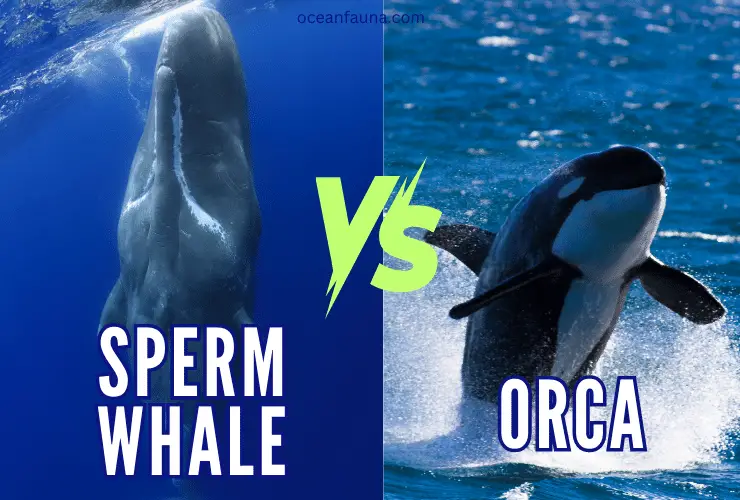
1 thought on “Sperm Whale vs Orca: Key Differences Explained”